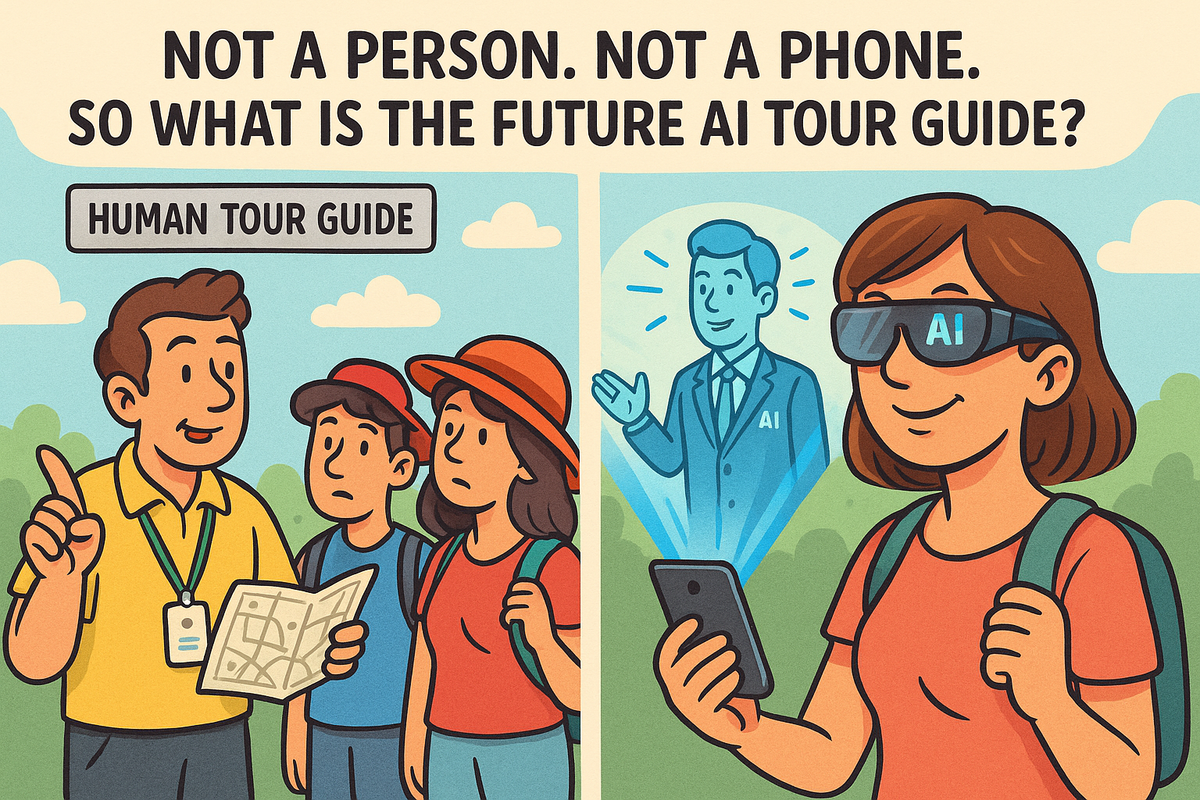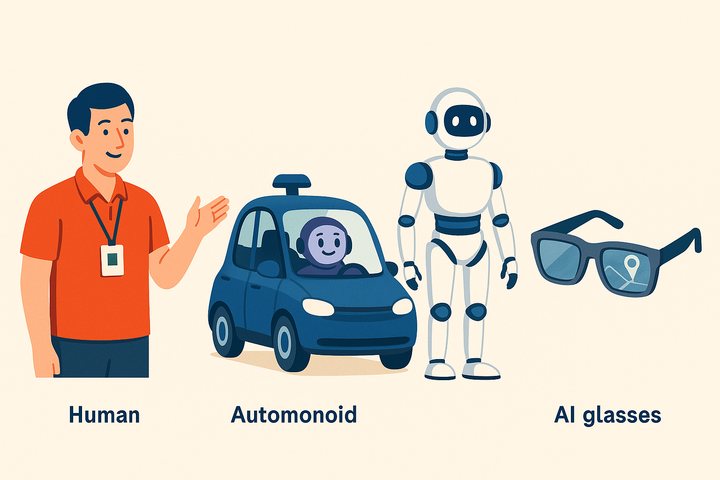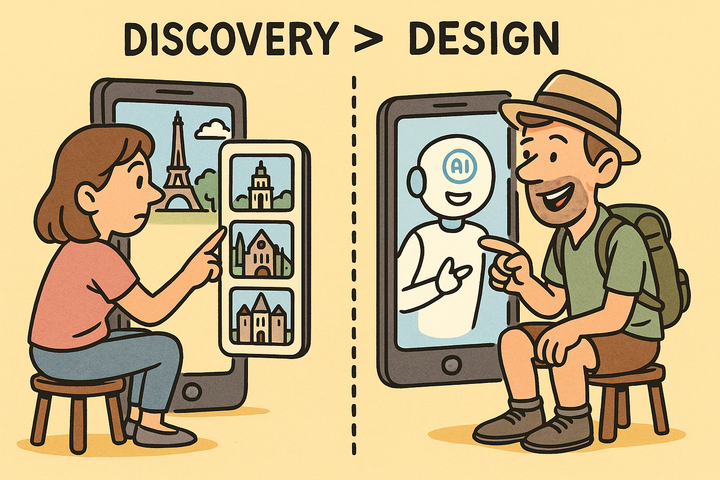Not a person. Not a phone. So what is the future AI tour guide?
From holograms to glasses, the future of guided travel is all about embedded intelligence

The final form factor for AI tour guides may not be smartphones but their presence is inevitable.
If you can imagine the future described by the CEO of OpenAI...
“Someday soon something smarter than the smartest person you know will be running on a device in your pocket, helping you with whatever you want.”
— Sam Altman
someday soon something smarter than the smartest person you know will be running on a device in your pocket, helping you with whatever you want.
— Sam Altman (@sama) August 5, 2025
this is a very remarkable thing.
...then why wouldn’t travellers use that power to guide themselves?
Anything else is wishful thinking or a nostalgic yearning for a bygone era.
Even the new CEO of Viator (by Tripadvisor) is on board:
“Would you want to do a tour led by AI? Probably yes - AI can do a phenomenal job in making it entertaining.”
PhocusWright Europe 2025
Usage evolution
In today’s pre-AI tour guide market, the typical guest leaves their hotel in the morning and returns later — let’s say they spend 8 to 12 hours out exploring (though the exact duration isn’t important).
Human tour guides, as it stands, play a relatively small role in that day. On a seven-day holiday, a traveller might book one or two guided experiences — maybe a walking tour, maybe a half-day trip. Even on a busy sightseeing day, the time spent with a guide is often just a few hours.
That means the current usage of human guides represents a small fraction of the total time travellers are open to guidance — well below 50% of the total addressable market (TAM), if measured by hours.
What fills the rest of that time? AI.
As AI capabilities grow, and the distinct value of human-led experiences remains constant, it follows that a greater share of the travel day will be filled by AI guidance. Not reaching 100%, because real human connection will always have a place, but increasing, inevitably, as AI becomes the default guide for everything in between.
Hardware: the form factor question
If AI tour guides are inevitable, the next question is: what form will they take?
Smartphones may be the starting point, but they’re unlikely to be the final destination. The AI of the near future will be embedded in new kinds of hardware — and the travel industry will need to be ready.
Here are some contenders:
Smartphone with hologram
Already in development in parts of Asia, including concept devices from Chinese manufacturers, we’re beginning to see smartphones capable of projecting 3D holograms or using mixed reality overlays. These could turn your phone into a miniature guide — one that speaks, gestures, and reacts to you in real time.
But phones still require you to hold them, look down, and interact manually. That’s not ideal for immersive, on-the-go experiences.
@maqaroon Making a giant hologram with the Google Pixel Fold! #satisfying #googlepixel #cute #diy (Werbung/Ad) #chiikawa #usagi #hachiware #kawaii #japan #peppersghost #hologram #phone #lifehacks #diy #craft #oddlysatisfying #bunny #dance #trend
♬ Da' Dip (ORIGINAL) - Freak Nasty
AI glasses
Meta, Apple, and others are betting big on smart glasses — a seamless, voice-activated interface between the digital and physical worlds. AI glasses could overlay information, translate signs, identify landmarks, and tell stories as you walk.
These are likely to be one of the most practical and widely adopted form factors for AI tour guidance, especially when paired with spatial audio and real-time language models.
AI pendant or bracelet
For those who want intelligence without visuals, wearable AI pendants or wristbands — like Humane’s AI Pin or Rabbit’s R1 — offer voice-based interaction with context-awareness. Lightweight, discreet, and hands-free, these could become the go-to travel companion for many.
Humanoid robots
Now for the wildcard. Will travellers bring their own humanoid robots on holiday?
If so:
- Will the robot stay in the hotel like luggage, or come along for the day?
- Will it have a distinct branded character — a James Bond tour led by Miss Moneypenny, for instance?
- Will travellers rent a robot that matches the brand they use at home, or just for a specific experience?
The answers aren’t clear yet, but if robots are treated like companions or personal assistants, branding, personality, and continuity will matter more than we expect.
Or… many AI touchpoints
Perhaps there won’t be one single AI device per guest — but many, interacting across the day:
- A robot waiter at breakfast
- An in-room concierge suggesting activities
- A wearable guide while sightseeing
- A smart vehicle that continues the narrative between locations
In that world, we need continuity of character, preferences, and memory. This is where standards like DIF's HATPro (which I’m a core contributor to) come in — allowing personality and guest data to move smoothly across devices and service providers.
And don’t forget vehicles
Vehicles are robots, too. From self-driving tour vans to AI-enabled rental cars, the guide might not be beside you — it might be driving you.
In every case, hardware will shape the guest experience. But the key isn’t just the form — it’s the continuity across form factors. Whether embodied in glasses, pendants, robots, or vehicles, the AI must be able to carry the guest’s context, preferences, and personality with it.
That’s what turns a tool into a tour guide.
Issues: who benefits from AI tour guides?
The rise of AI tour guides brings not just innovation — but a real risk.
If travellers rely on generic, cloud-based assistants like ChatGPT or similar tools developed outside the industry, local economic impact is lost. There’s no benefit to the local guide, the small operator, or the entrepreneur who has built their livelihood on delivering meaningful, human travel experiences.
The existential challenge isn’t whether AI tour guides will exist — it’s who builds them, and who benefits from them.
That’s why we must ensure AI tour guides come from within the industry.
- Built with local knowledge
- Aligned with the values of travel
- Designed to support and extend human-led experiences, not replace them
This is exactly the future I’m working toward — AI tour guides that strengthen the local travel ecosystem rather than bypass it entirely.
Because the only thing worse than being disrupted by AI… is being ignored by it.
Want to read more like this?
Low volume. Short length. Focused content.
We know you're busy — only the good stuff, no noise.



